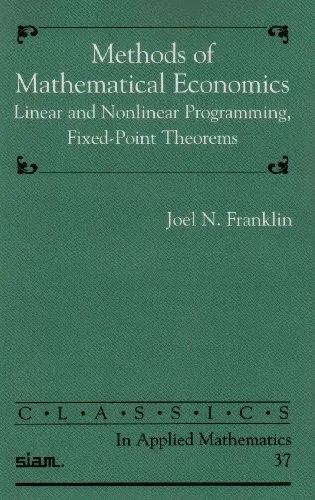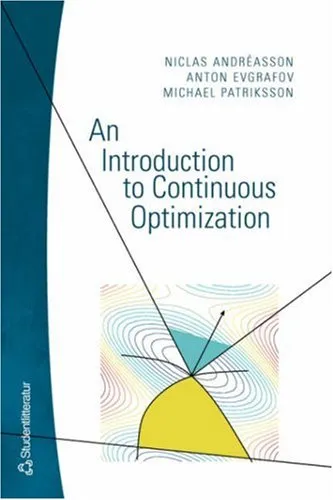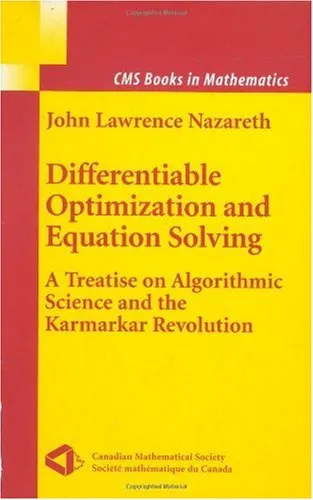Methods of Mathematical Economics: Linear and Nonlinear Programming, Fixed-Point Theorems (Classics in Applied Mathematics, 37)
4.5
Reviews from our users

You Can Ask your questions from this book's AI after Login
Each download or ask from book AI costs 2 points. To earn more free points, please visit the Points Guide Page and complete some valuable actions.Related Refrences:
Welcome to an exploration of the mathematical foundations that propel the field of economics towards precision and innovation. "Methods of Mathematical Economics: Linear and Nonlinear Programming, Fixed-Point Theorems" is a seminal text that bridges mathematical theory with economic applications, providing readers with a comprehensive toolkit to approach complex economic problems.
Detailed Summary of the Book
The book is a profound journey into the symbiosis of mathematics and economics, crafted to appeal to both scholars and practitioners. Starting with linear programming, it lays the groundwork by illustrating how optimal resource allocation can be formulated and solved using linear constraints. Delving into the intricacies of nonlinear programming, the text transitions into more complex economic scenarios where relationships are not bound by linear proportionality.
One of the core discussions revolves around fixed-point theorems, crucial in proving the existence of solutions in various economic models. These theorems provide the mathematical bedrock for equilibrium analysis, which is central to economic theory. Throughout the text, the author employs rigorous proofs while maintaining accessibility for those less familiar with high-level mathematics, ensuring that readers can grasp the concepts without extensive prior knowledge.
Moreover, the book doesn't merely present mathematics in isolation; it ventures into real-world applications, demonstrating how these mathematical methods can be applied to solve pressing economic issues. From optimizing production plans to analyzing market equilibria, the practicality of the discussed methods is apparent, making the book an indispensable resource for anyone looking to apply mathematical concepts to economic questions.
Key Takeaways
- Comprehensive coverage of both linear and nonlinear programming techniques.
- In-depth exploration of fixed-point theorems and their economic applications.
- Bridging the gap between theory and practice with numerous real-world examples.
- A strong emphasis on the mathematical underpinnings of economic equilibrium and optimization.
- An accessible approach that demystifies complex mathematical concepts for a broad audience.
Famous Quotes from the Book
While the book is primarily a technical text, it contains insights that resonate deeply within the field of mathematical economics:
"The structure of economic models mirrors the intricacies of human decision-making, bound by constraints yet driven by ingenuity."
"Optimization is not merely a mathematical endeavor but a fundamental quest in economics, aiming to balance scarcity and need."
Why This Book Matters
"Methods of Mathematical Economics" is not just a text; it is a bridge between disciplines, expanding the toolkit of economists with precision and clarity. Mathematics is the language in which the universe's logic is written, and in economics, this language translates into tools for better decision-making, policy formulation, and strategic planning.
This book matters because it equips economists with the necessary mathematical skills to tackle modern economic challenges. From academics shaping the future of economic thought to practitioners influencing policy and business strategy, the insights garnered from this text have a profound impact.
Furthermore, by providing a lucid and comprehensive treatment of complex topics, the book also inspires a deeper appreciation for the interconnectedness of mathematics and economics. It fosters a mindset where quantitative reasoning complements qualitative insights, leading to a more robust understanding of economic phenomena.
Free Direct Download
You Can Download this book after Login
Accessing books through legal platforms and public libraries not only supports the rights of authors and publishers but also contributes to the sustainability of reading culture. Before downloading, please take a moment to consider these options.
Find this book on other platforms:
WorldCat helps you find books in libraries worldwide.
See ratings, reviews, and discussions on Goodreads.
Find and buy rare or used books on AbeBooks.
1261
بازدید4.5
امتیاز50
نظر98%
رضایتReviews:
4.5
Based on 0 users review
"کیفیت چاپ عالی بود، خیلی راضیام"




